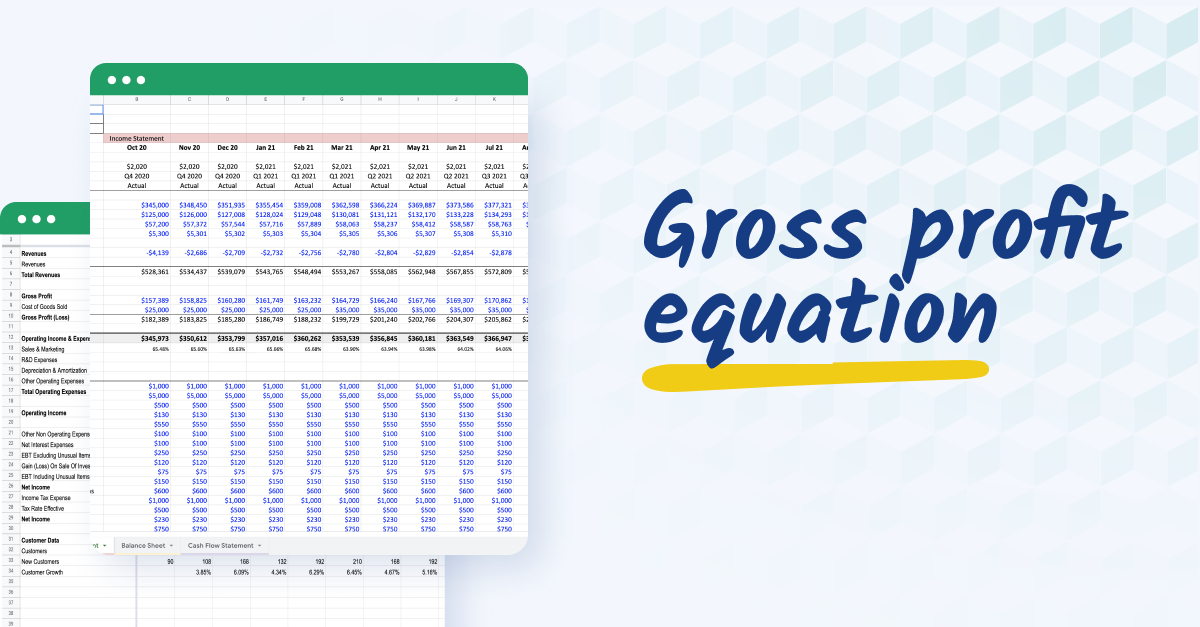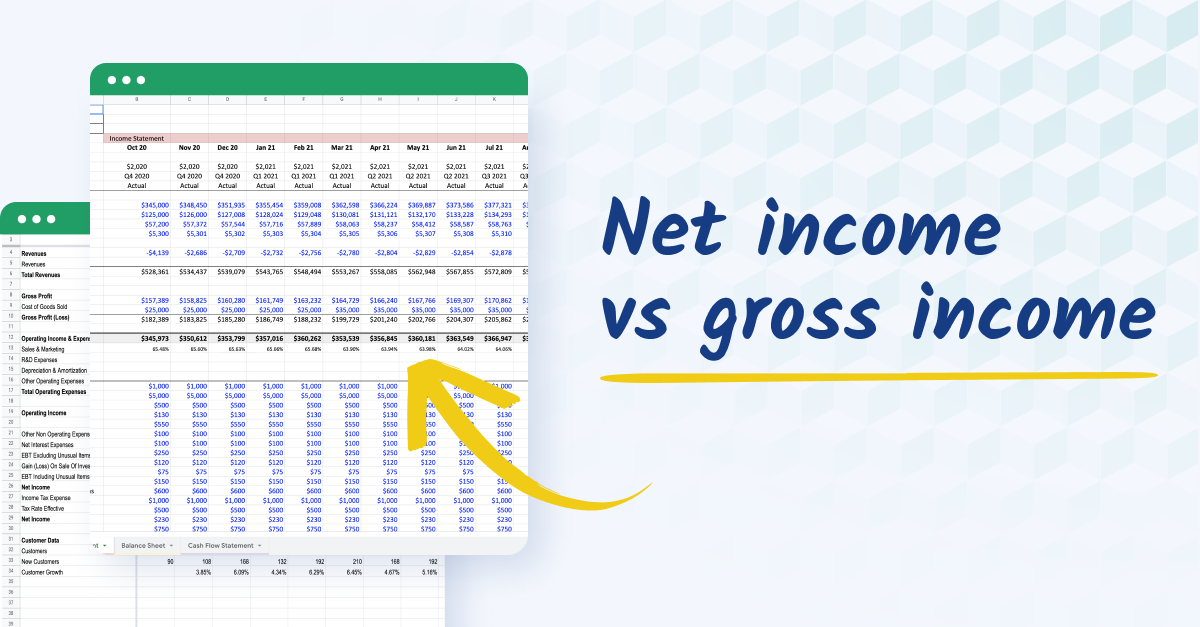Key takeaways
- Gross profit gives insight into the efficiency of a company's core operations by subtracting the cost of goods sold (COGS) from total revenue.
- You calculate gross profit by calculating your revenue and then subtract the cost of goods sold.
- Gross profit margin shows how efficiently a company turns revenue into profit relative to its production costs.
What is gross profit?
Gross profit is a company’s profit once you deduct the costs required for creating and selling its products or services. Also known as sales profit or gross income, you can analyze gross profit to explore your pricing and how well you’re controlling production costs—two key indicators for profitability analysis.
Gross profit is always less than total sales, which measures total revenue and ignores production costs, and always more than net profit, which is gross profit minus operating expenses and taxes.

Why is it important for finance teams to measure gross profit?
Measuring gross profit gives finance teams an objective view of their profitability from their core operations. By removing the direct costs from your total sales, you can see how efficiently you produce goods. FP&A specialists use it for everything from measuring profitability and evaluating production efficiency to tracking changes to your processes and in the market at large.
Tracking your gross profit margin over time is an accurate way of monitoring performance year on year. This data helps finance teams make informed decisions on pricing strategies, cost management, and operational efficiencies.
Where is gross profit on the income statement?
Gross profit appears high on the income statement—just underneath revenue and cost of goods sold. As a general rule, lines that are high on the income statement are important, and gross profit is no exception. Gross profit is expressed as a currency (e.g., $1,000,000) and you can convert it into a percentage to see your gross profit margin.
What is the difference between gross profit vs gross profit margin?
Gross profit is the dollar amount a business earns from its core operations after subtracting the cost of goods sold (COGS) from total revenue. In contrast, gross profit margin is expressed as a percentage, calculated by dividing gross profit by revenue and multiplying by 100.
Gross profit shows the actual monetary value retained from sales while gross profit margin shows how efficiently a company turns revenue into profit relative to its production costs–which is a more comparative measure of profitability.
What is considered a good gross profit?
As you might expect, a higher gross profit shows stronger profitability and operational efficiency. But that’s not the full story.
A multinational’s million-dollar gross profit may be higher than a mom-and-pop shop's $100,000, but that doesn’t mean it’s “better.” Gross profit varies by company size, which is why a gross profit margin gives a more accurate picture of success.
A good gross profit margin usually exceeds 20%, but this varies depending on your industry. For example, industries with high production costs, like manufacturing, may have lower gross profit margins compared to service-based businesses, where overhead tends to be lower.
Financial services, like regional banks, mortgages, and insurance brokers enjoy gross profit margins above 80%. At the other end of the scale, car manufacturers, mining, and food distribution all have high raw material costs, so a good gross margin profit could be 10%.

How to calculate gross profit
Calculating gross profit is a simple subtraction. You take your revenue, subtract the cost of goods sold, and you have your answer.
However, that means you need reliable figures for your revenue and cost of good sales. Most companies use financial planning and analysis software to cut out uncertainty and save time when sourcing these figures.
Gross profit formula
The formula for gross profit is:
Gross profit = Revenue − cost of goods sold
Financial planners will select a particular sales period to analyze—a year or a quarter, for example—to measure their gross profit over time. This allows for more meaningful analysis, such as a year-on-year comparison, to give a greater insight into progress.
Cost of goods sold
Your cost of goods sold combines all direct costs associated with producing goods. This includes direct labor and materials used in the process of creating items or services but excludes indirect costs like overheads, marketing, and sales.
COGS vary depending on the industry. For example, a manufacturing business would include raw materials and wages for factory workers while a service-based business may only include wages for service providers and software subscriptions.
Here’s a quick cheat sheet for the most common COGS:
- Raw materials
- Direct labor costs
- Sales staff commissions
- Credit card processing fees
- Equipment costs, including maintenance and depreciation
- Utilities related to the production facility
- Shipping expenses
You can pull your COGS figure directly from the income statement, where it appears directly under revenue, near the top of the statement.
Revenue
Revenue, or net sales, is the total income you get from selling your goods or services before any expenses are deducted. It sits right at the top of your income statement and informs several calculations, from profitability analysis to pricing and supply chain management.
Revenue can come from product sales, service fees, subscriptions, or other business activities. In a typical income statement, revenue is reported as gross revenue, which doesn’t account for any costs associated with generating that income.
However, revenue does take discounts and returns into consideration, which is why it is also referred to as “net sales”.
Calculating revenue involves multiplying the number of units sold by the price per unit. You can also add all income from services rendered over a specific period and subtract any discounts or returns.
While it’s not a complicated calculation, still take extra care. Gross profit miscalculations can have serious ripple effects. For example, failure to take note of discounts can give a false report of your profitability, which has an impact on forecasting and budgeting.

Gross profit calculation example
Let’s take an example of a real estate development company, Urban Estates, that wants to develop a set of townhouses.
1. Calculate the total revenue
Urban Estates completed and sold 10 townhomes at $300,000 each.
Revenue = 10 townhouses x $300,000 dollars = $3,000,000.
2. Calculate COGS
COGS for this project includes all the direct costs involved in developing the townhomes: materials, labor, permits, and construction overhead. Here’s a breakdown of the COGS for Urban Estates:
- Construction materials: $1,000,000
- Direct labor (contractors, builders): $700,000
- Permit and land development fees: $200,000
- Utilities and site management: $100,000
Therefore, the total COGS for the project is:
COGS = $1,000,000 + $700,000 + $200,000 + $100,000 = $2,000,000
3. Calculate the gross profit
Now that we have both revenue and COGS, we can calculate gross profit:
Gross profit = revenue − COGS = $3,000,000 − $2,000,000 = $1,000,000
This is an excellent return that shows how efficient Urban Estates is at managing construction and material costs.

Advantages and limitations of using gross profit
The role of gross profit is to clear away distracting numbers and figures so you can laser focus on your product performance and analyze your cost control strategy.
However, concentrating on a specific set of expenses means excluding other considerations. This can give a misleading picture of your organization’s overall performance, especially in industries with very low COGS, but high marketing and non-operating costs.
Let’s take a closer look at the advantages and limitations of using gross profit.
Advantages of using gross profit
- Monitors production efficiency: Gross profit highlights how effectively a business manages the direct costs associated with producing goods or services.
- Informs cost control strategy: It helps identify areas where production or material costs can be reduced.
- Guides pricing strategies: Businesses can use gross profit to assess whether their pricing covers direct costs and contributes to profitability.
- Simple to calculate: Gross profit is an easily accessible metric for finance teams and provides straightforward insights into operational performance.
- Useful for comparisons: It allows businesses to compare their performance over time or against competitors in the same industry.
Limitations of using gross profit
- Excludes indirect expenses: Gross profit does not account for administrative, marketing, or financing costs, which are important for understanding overall profitability.
- Limited in service-based industries: It may not provide meaningful insights for service-oriented businesses, where overhead and personnel costs are more significant than direct production costs.
- Not a complete profitability measure: Gross profit only reflects core operational efficiency and doesn’t capture non-operating expenses, which can impact a business’s financial health.
- Less useful in overhead-heavy industries: In industries like financial or business services or tech, where indirect costs and non-operating expenses play a larger role, gross profit might provide an incomplete view of a company’s financial performance.
Automate your gross profit calculations
Calculating gross profit is the starting point for a whole host of performance measurements and future calculations, so you need to be sure about your numbers.
That’s why finance teams from all industries are simplifying the process, using automated software like Cube to pull real-time revenue and COGS figures and calculate gross profits automatically.
To see how you can accurately calculate gross profit in a fraction of the time, sign up for a free demo with Cube.



.png)












![Contribution margin income statements: a complete guide [2025]](https://www.cubesoftware.com/hubfs/contribution%20margin%20income%20statement%20%281%29.png)